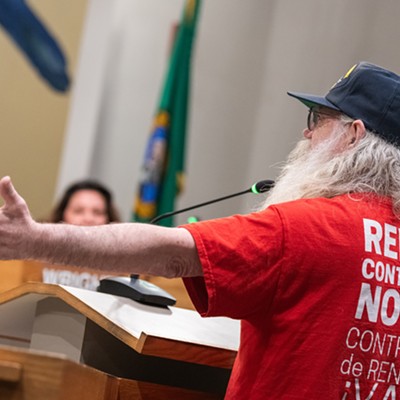Back into society
[
{
"name": "Broadstreet - Instory",
"component": "25846487",
"insertPoint": "4",
"requiredCountToDisplay": "4"
},{
"name": "Broadstreet - Empower Local",
"component": "27852456",
"insertPoint": "8",
"requiredCountToDisplay": "8"
},{
"name": "Broadstreet - Instory",
"component": "25846487",
"insertPoint": "12",
"requiredCountToDisplay": "12"
},{
"name": "Broadstreet - Instory - 728x90 / 970x250",
"component": "27852677",
"insertPoint": "18",
"requiredCountToDisplay": "18"
},{
"name": "Broadstreet - Instory",
"component": "25846487",
"insertPoint": "5th",
"startingPoint": "23",
"requiredCountToDisplay": "24",
"maxInsertions": 100
}
]
& & by Pia K. Hansen & & & &
If criminals make up the lowest caste in our society, then sex criminals are the lowest of the low. In jail, they are often threatened by their fellow inmates and sometimes violently assaulted -- especially the ones who have committed crimes against children. Outside of jail, they are looked upon as monsters with no conscience, no mercy and no redeeming qualities. It's not hard to understand why. Their case histories read like scripts for bad horror movies featuring plots about stolen childhoods, abuse, sexual violence and broken lives. They leave victims behind who will never be the same as before a sex offender entered their lives by force.
One local man was released after serving eight years for the first-degree rape of two children -- an 8-year-old boy and a 4-year-old girl. This offender later violated the terms of his release by immediately having several unsupervised contacts with neighborhood children. He was put back in jail, but has now been released in northeast Spokane.
Another sex offender was released into downtown Spokane in November, after serving 12 years for two counts of first-degree child rape. This man was babysitting some of his victims, one of whom was 8 years old. While on probation the first time around, he violated his restrictions by raping a 14-year-old girl.
Another man was convicted in Spokane for the first time in 1974. Convictions for indecent exposure and attempted kidnapping followed at a steady rate. In one case, he raped a woman in front of her small children. He was released here in May 2000.
These are just a handful of the sex offenders who have been released into the community, under supervision, over the past year. More and more of them are going to move into local neighborhoods, as the state of Washington struggles to restructure the way it deals with predatory sex criminals.
A recent ruling by U.S. District Judge William Dwyer saying the state's sex offender program needs to be brought up to constitutional standards has sent the Department of Social and Health Services (DSHS) searching for a new site for a low-security sex offender facility. The state already has several residential facilities, such as the McNeil Island Correction Center in Puget Sound under the Department of Corrections (DOC), but Dwyer also said the offenders must be offered an opportunity to make their way back into society. The term for this transition is "civil commitment," and it's administered by DSHS. Under this type of commitment, the offender is not in jail, but not exactly free either. Typically, civil commitment involves supervised living quarters of some sort, such as a halfway house or a registered address, combined with restrictions on the offender's whereabouts.
But it's the talk about halfway houses that worries Danielle Lane, a longtime resident of Airway Heights. She, along with many other residents there and in Medical Lake, recently discovered that both towns were considered as possible sites for these halfway houses that DSHS is going to build for violent sex offenders.
"We were so surprised. We didn't know anything. Our biggest concern is that our city stays safe, and we are worried about the welfare of our children," says Lane, who's the vice chair of the Airway Heights Citizens Action Group. "We are highly concerned that the sex offenders at the halfway houses may reoffend. We were told that they are the most likely to do so. Terms like 'the worst of the worst' were used in describing them."
Over the past few weeks, several public meetings were held in Airway Heights, where legislators and DSHS officers listened to passionate and heartfelt testimony against the facility.
"Personally, I'm concerned that we have done more than our fair share already," says Dale R. Perry, a City Council member in Airway Heights. "They just want to keep dumping more on us because we are considered a low income or poor community, and they don't think we have the money to fight this. People don't realize Airway Heights already has sex offenders. We are concerned about the property values out here, I mean, citizens are already talking about selling their homes. We wouldn't feel safe with a facility like that out here."
Some sex offenders are living under community supervision in Airway Heights already, but more are housed at the nearby Geiger Correctional Facility.
"They walk away from the prison, so why should we believe that they won't walk away from a halfway house?" asks Perry. "Our major concern is, if they want out bad enough, they will get out." Both cities and Spokane County passed emergency ordinances saying sex offender facilities cannot be built within their jurisdiction.
For now the resistance has paid off, since both Medical Lake -- where Eastern State Hospital is located -- and Airway Heights are off the hook. Walla Walla has been chosen as a preferred site for the first halfway houses, because the state already owns property outside the Washington State Penitentiary there, and that's where the halfway houses may be built.
Of course, residents in Walla Walla are not very welcoming of the idea that violent sex criminals may move to the outskirts of town, and the City Council has passed the same moratorium on sex offender facilities as Spokane County.
The Walla Walla Council has taken things one step further by also suing DSHS, saying that the department didn't follow the correct procedures in selecting the site. Citizens in Airway Heights will sue as well if that's what it takes to keep the sex offenders out, says Perry. The two sites do have in common that they are both in Eastern Washington, raising the question among some about whether Eastern Washington is viewed as a penal colony for the West Side's discontents.
"I worry about my wife and my grandkids," says Perry. "These sex offenders have nothing to lose. They are molesters and rapists and those who kill and torture. In talking to people who have worked with these offenders, I've heard that if they get out, they are going to do it again. It's a sickness. If you can't cure them, are you then going to keep letting them out to go do it again and again and again?"
offenders among us
Releasing sex offenders into the community is nothing new. Just like any other criminal, a sex offender serves his time and is then released. Under Washington law, sex offenders convicted after February 28, 1990, or who are under active supervision for sex offenses or who have been convicted as sexually violent predators, must register with local police.
Upon registration, information about who they are, what crimes they committed and where they are going to be living is released to the community. Fliers are distributed and especially schools and daycare centers are informed, and the sex offender has to notify the local police department if he is moving.
Within Spokane city limits, two detectives are in charge of keeping track of the registered offenders, and the way they are doing things is regularly held up as a model for other communities in the state and across the nation.
"Five years ago, when I started in this department, we had about 850 registered sex offenders living within the Spokane city limits," says Detective Dennis Walther, one of the two SPD detectives who are assigned to monitor sex offenders. "Today, we have 669, levels one, two and three. It was down to around 475 about a year ago."
There are another 458 registered sex offenders living outside the city, bring the Spokane County total to 1,127.
The biggest fear surrounding released sex offenders is that they will reoffend. Since data from national, statewide and local studies paint very different pictures of the level of reoffense -- or recidivism -- it is very difficult to get an accurate assessment as to whether this is likely to happen. Recidivism rates range from as low as 2 percent (after treatment) to as high as 50 or 60 percent, 15 years after the first conviction. But Walther says he has conducted a study of the numbers in Spokane and found that sex offenders don't offend again and again.
"It's public opinion that sex offenders reoffend 99 percent of the time, but that is simply not true," he says. "We looked at sex offenders over a 20-year period, that involved 5,000 offenders. Over the first five years after their release, 15 percent reoffended. Over the next 20 years, about another 15 percent reoffended. So all together that's a little over 30 percent in any manner. The old adage that they all reoffend all the time is not true."
The Center for Sex Offender Management (CSOM) supports Walther's findings. A collaborative effort between the Office of Justice Programs, the National Institute of Corrections and the State Justice Institute, CSOM estimates that among child molesters the recidivism rate is 13 percent for sex offenses and 37 percent for other non-sex offenses, over a five-year period. Rapists, on the other hand, had a 19 percent recidivism rate for sex offenses and a 46 percent recidivism rate for non-sex offenses. Of course, the only numbers registered are for offenders who are caught, and some offenses are never reported or prosecuted.
The reoffense rates of sex offenders are lower than for the general criminal population, according to data released by the CSOM. One study, which looked at more than 100,000 non-sex criminals released from prison in 11 states, found that nearly 63 percent were rearrested for a non-sexual felony or a serious misdemeanor within three years of their release. Ultimately, 41 percent returned to jail.
"When it comes to controlling reoffense, we believe in community supervision. The more people who know about the sex offender, the better," says Walther. "I usually tell people, it's like if you are a cop, and cops like donuts, and you want to go on a diet. You tell your wife you'll give her $500 if you eat another donut. Then she tells all her friends and they tell their friends and soon everyone is watching you to see if you eat donuts. Community supervision works the same way. I don't think a sex offender will put himself in a position to reoffend if everyone is watching him."
back where they came from?
When faced with having sex offenders moving in next door, most people come down with a serious case of not-in-my-back-yard. During the past election, many political candidates were running on the sex offender platform. Some claimed Eastern Washington is being turned into a dumping ground for offenders from all over the state, but again the SPD's statistics do not support this claim.
"About 64-65 percent of the offenders who live here were convicted here. Everybody says they should go back to where they are convicted, but what I'm saying is we don't want to go there," says Walther. "I know we have 18 [registered sex offenders] from other places, but King County has between 40 and 50 from Spokane."
In other words, if all the offenders who offended in Spokane but moved away came back, and all the ones who offended somewhere else but are living here moved away, Spokane would have more sex offenders living in the community than today.
"Spokane exports more offenders than it imports," says Jerry Keller, Walther's partner on the SPD. "True story. We send more to the West Side than they send to us."
the tracking system
A sex offender is a person convicted of a felony sex crime, which includes almost any sex crime, such as rape, child molestation and selling child pornography, except soliciting a prostitute, which is an exception.
Upon release, sex offenders are assessed and rated as to whether they are likely to reoffend. "It's quite clear how that's calculated," says Keller. "There is something called a Washington State Scoring Tool, which the sentencing review board in Olympia uses to determine what level the offenders are when released from prison. It's like a four-page document which takes their history into account, and at the end of that scoring it's all added up and the person is then either a level one, two or three. That recommendation is sent to the local law enforcement. "
Level three offenders are considered the highest risk to the community because they tend to actively seek out their victims. A level three offender may solicit babysitting jobs as a way of getting in touch with potential victims, or otherwise groom targets for later offenses by making friends with them. Level three offenders are commonly thought of as predators.
"Out of the 669 offenders currently living within the city limits, 79 are level three offenders and 53 are level two," says Keller.
A level two offender is a moderate risk to the community, but not considered a predator. And a level one offender -- typically an incest offender -- is considered a low risk for the community. If a level one offender reoffends, he is automatically boosted to a level two or three, depending on the offense.
"We stress that this rating is based on known information," says Keller. "Obviously there are probably level ones who should be level two or threes, but from what we know they are level ones. And it's not like they have to commit five rapes to be level three offenders, but usually the level threes have committed more than one offense."
Knowing exactly how many sex offenses a perpetrator has committed is difficult, because many sex crimes go unreported. As few as 16 percent of all committed rapes are reported, and some victims' advocates say that nowhere near every perpetrator is caught.
"There are some offenders who have offended again and again, but they may only be convicted of one or two charges, because they are the only ones that hold up in court," says Marcia Gallucci, advocate coordinator and legal advocate of Spokane Sexual Assault Center under Lutheran Social Services. "They may have 15 victims out there that we don't know about. An offender could qualify as a serial rapist, and we don't know. Nothing happens to him simply because he may have figured out how to rape and get away with it."
Another problem, she adds, is that 85 percent of the cases she deals with are date or acquaintance rape cases, many of which don't hold up in court. It's a myth that the brunt of sex crimes are committed by a lurking predator waiting in a dark parking lot. Most sexual assaults (84 percent) are committed inside the victim's home by someone the victim knows. A 1998 National Violence Against Women Survey revealed that among the women who reported being raped, 76 percent fell victim to a current or former husband, a date or a live-in partner.
CSOM estimates that 60 percent of boys and 80 percent of girls who are sexually victimized are abused by someone they know or someone who knows their family. So just because the police know where the registered sex offenders are living doesn't mean there won't be any more sexual assault victims in the community.
And the police do know where they live and are indeed keeping an eye on them, because they have to register.
If convicted of a Class A felony (first- and second-degree rape), the offender must register his address for life. If convicted for a Class B felony (second-degree child molestation), the offender must register for 15 years. When convicted for a Class C felony (third-degree child molesting, sexual misconduct with a minor), an offender must register for 10 years.
"It used to be that sexual misconduct with a minor was not registerable, but I went with my old partner to the state legislature during a session and had that changed," says Keller. "I think we are going to try to do this with possession of child pornography as well."
Registration is a serious matter. After moving from one residency to another, a registered sex offender has between 24 and 72 hours to register his new address with the police department.
"We have a book with all the level two and three offenders in it -- their pictures and everything -- and we check up on them at least once a month," says Keller. "We have a few women in there as well. I think we figured it was about 2 percent females among registered sex offenders."
If patrol officers stop registered sex offenders and they give an address that doesn't match the one the SPD has, a warrant is issued right away. Getting booked for failure to register is itself a Class C felony.
But SPD has not always gone door to door to check up on the offenders. Actually, sex offenders are tracked a lot more meticulously today than just five years ago.
"When I started back here in '92, nobody was checking on the sex offenders even though the law [the Sex Offender Registry Act] had been in effect for two years. Today, we go by and make sure they are living where they are supposed to," says Keller. "Before we started doing that, approximately 90 percent of them were not living where they were supposed to. The last four years, we've changed that around to 95 percent actually living where they should be. I would say these are some of the best statistics in the state."
Keller says the sex offenders are so aware of the periodic house checks, that some of them will call and check on the detectives if they haven't seen them in awhile.
"They know we are watching over them, and they are so worried we will miss them, that they call in," he says. "It's just like, 'Um, Detective Keller or Detective Walther, I haven't seen you in a couple of weeks. Where are you?'"
the toll on victims
The United States has the highest reported rate of rape when compared to other countries that publish such statistics, according to the Washington Coalition of Sexual Assault Programs.
The safety of the community is constantly being balanced against the rights of the offender. Some argue that it's unfair to publicize photos of offenders once they have served their sentence. Others say that the low emphasis on treatment in the prison system ruins any chance of rehabilitation, but victim advocates are tired of all the focus on the offenders. Still others wonder why those convicted of such heinous crimes are out in such a seemingly short amount of time -- especially when compared to non-violent drug offenders who are incarcerated with strict mandatory sentences.
"I'm so glad we are including the victims in this talk," says Spokane Sexual Assault Center's Gallucci. "The emphasis needs to be back on the victim and the victim's family a little bit more. Right now, it's on the offender and his rights and his problems."
Sexual assault victims are often traumatized for life. When the anniversary date for the assault comes around, for instance, it may trigger repeated trauma year after year.
"We have this situation where perpetrators can get treatment and maybe help finding a place to live [once they get out of jail], but nobody is providing those services for the victims," says Gallucci. "Just the other day, this one lady called me and said, 'I lost my job, I'm beginning to use [drugs], I don't have a car and I can't do anything.' The victims are in a very difficult position." Many times, victims of sex crimes are having a more difficult time recovering than other crime victims.
"Being a victim of a sex crime is different than being a victim of any other crime, because it's a crime against you, not your house or your car," says Gallucci. "It takes away the essence of who the person is and the rights to choices about your body because it is such a personal -- even a spiritual -- crime. Today, we know a lot about recovery, but that doesn't mean people don't experience the trauma. They still do."
Still, no amount of punishment can take away the damage -- only prevention offers hope, and Gallucci supports the efforts of reintroducing offenders into the community. "This is a valid approach to release offenders into the community the way we do," she says. "The people at the COPS stations and SCOPE do a wonderful job of notifying people. But sex offenses are still an area of human behavior that has parents very nervous and frightened."
Back in Airway Heights, Danielle Lane readily admits to being both. "We are worried about the welfare of our children; the environment is full of potential victims out here," she says. "The DSHS says the halfway houses can't be in eyesight of a park, a school and a church. Well, this site is in sight of the park and down the street is the church, and the park is connected to the elementary school. It's not right."
She doesn't advocate harsher laws or more radical measures, but she wants sex offenders under stricter control -- not just in Airway Heights. "This is not just about us and Airway Heights. We don't believe these halfway houses are safe anywhere. The offenders need help, they need live-in counseling, not just some experimental treatment," says Lane. "Moving them out here would be like sending an alcoholic to a bar and putting a beer at the other end of bar and say, 'No you can't have that.' "
If criminals make up the lowest caste in our society, then sex criminals are the lowest of the low. In jail, they are often threatened by their fellow inmates and sometimes violently assaulted -- especially the ones who have committed crimes against children. Outside of jail, they are looked upon as monsters with no conscience, no mercy and no redeeming qualities. It's not hard to understand why. Their case histories read like scripts for bad horror movies featuring plots about stolen childhoods, abuse, sexual violence and broken lives. They leave victims behind who will never be the same as before a sex offender entered their lives by force.
One local man was released after serving eight years for the first-degree rape of two children -- an 8-year-old boy and a 4-year-old girl. This offender later violated the terms of his release by immediately having several unsupervised contacts with neighborhood children. He was put back in jail, but has now been released in northeast Spokane.
Another sex offender was released into downtown Spokane in November, after serving 12 years for two counts of first-degree child rape. This man was babysitting some of his victims, one of whom was 8 years old. While on probation the first time around, he violated his restrictions by raping a 14-year-old girl.
Another man was convicted in Spokane for the first time in 1974. Convictions for indecent exposure and attempted kidnapping followed at a steady rate. In one case, he raped a woman in front of her small children. He was released here in May 2000.
These are just a handful of the sex offenders who have been released into the community, under supervision, over the past year. More and more of them are going to move into local neighborhoods, as the state of Washington struggles to restructure the way it deals with predatory sex criminals.
A recent ruling by U.S. District Judge William Dwyer saying the state's sex offender program needs to be brought up to constitutional standards has sent the Department of Social and Health Services (DSHS) searching for a new site for a low-security sex offender facility. The state already has several residential facilities, such as the McNeil Island Correction Center in Puget Sound under the Department of Corrections (DOC), but Dwyer also said the offenders must be offered an opportunity to make their way back into society. The term for this transition is "civil commitment," and it's administered by DSHS. Under this type of commitment, the offender is not in jail, but not exactly free either. Typically, civil commitment involves supervised living quarters of some sort, such as a halfway house or a registered address, combined with restrictions on the offender's whereabouts.
But it's the talk about halfway houses that worries Danielle Lane, a longtime resident of Airway Heights. She, along with many other residents there and in Medical Lake, recently discovered that both towns were considered as possible sites for these halfway houses that DSHS is going to build for violent sex offenders.
"We were so surprised. We didn't know anything. Our biggest concern is that our city stays safe, and we are worried about the welfare of our children," says Lane, who's the vice chair of the Airway Heights Citizens Action Group. "We are highly concerned that the sex offenders at the halfway houses may reoffend. We were told that they are the most likely to do so. Terms like 'the worst of the worst' were used in describing them."
Over the past few weeks, several public meetings were held in Airway Heights, where legislators and DSHS officers listened to passionate and heartfelt testimony against the facility.
"Personally, I'm concerned that we have done more than our fair share already," says Dale R. Perry, a City Council member in Airway Heights. "They just want to keep dumping more on us because we are considered a low income or poor community, and they don't think we have the money to fight this. People don't realize Airway Heights already has sex offenders. We are concerned about the property values out here, I mean, citizens are already talking about selling their homes. We wouldn't feel safe with a facility like that out here."
Some sex offenders are living under community supervision in Airway Heights already, but more are housed at the nearby Geiger Correctional Facility.
"They walk away from the prison, so why should we believe that they won't walk away from a halfway house?" asks Perry. "Our major concern is, if they want out bad enough, they will get out." Both cities and Spokane County passed emergency ordinances saying sex offender facilities cannot be built within their jurisdiction.
For now the resistance has paid off, since both Medical Lake -- where Eastern State Hospital is located -- and Airway Heights are off the hook. Walla Walla has been chosen as a preferred site for the first halfway houses, because the state already owns property outside the Washington State Penitentiary there, and that's where the halfway houses may be built.
Of course, residents in Walla Walla are not very welcoming of the idea that violent sex criminals may move to the outskirts of town, and the City Council has passed the same moratorium on sex offender facilities as Spokane County.
The Walla Walla Council has taken things one step further by also suing DSHS, saying that the department didn't follow the correct procedures in selecting the site. Citizens in Airway Heights will sue as well if that's what it takes to keep the sex offenders out, says Perry. The two sites do have in common that they are both in Eastern Washington, raising the question among some about whether Eastern Washington is viewed as a penal colony for the West Side's discontents.
"I worry about my wife and my grandkids," says Perry. "These sex offenders have nothing to lose. They are molesters and rapists and those who kill and torture. In talking to people who have worked with these offenders, I've heard that if they get out, they are going to do it again. It's a sickness. If you can't cure them, are you then going to keep letting them out to go do it again and again and again?"
offenders among us
Releasing sex offenders into the community is nothing new. Just like any other criminal, a sex offender serves his time and is then released. Under Washington law, sex offenders convicted after February 28, 1990, or who are under active supervision for sex offenses or who have been convicted as sexually violent predators, must register with local police.
Upon registration, information about who they are, what crimes they committed and where they are going to be living is released to the community. Fliers are distributed and especially schools and daycare centers are informed, and the sex offender has to notify the local police department if he is moving.
Within Spokane city limits, two detectives are in charge of keeping track of the registered offenders, and the way they are doing things is regularly held up as a model for other communities in the state and across the nation.
"Five years ago, when I started in this department, we had about 850 registered sex offenders living within the Spokane city limits," says Detective Dennis Walther, one of the two SPD detectives who are assigned to monitor sex offenders. "Today, we have 669, levels one, two and three. It was down to around 475 about a year ago."
There are another 458 registered sex offenders living outside the city, bring the Spokane County total to 1,127.
The biggest fear surrounding released sex offenders is that they will reoffend. Since data from national, statewide and local studies paint very different pictures of the level of reoffense -- or recidivism -- it is very difficult to get an accurate assessment as to whether this is likely to happen. Recidivism rates range from as low as 2 percent (after treatment) to as high as 50 or 60 percent, 15 years after the first conviction. But Walther says he has conducted a study of the numbers in Spokane and found that sex offenders don't offend again and again.
"It's public opinion that sex offenders reoffend 99 percent of the time, but that is simply not true," he says. "We looked at sex offenders over a 20-year period, that involved 5,000 offenders. Over the first five years after their release, 15 percent reoffended. Over the next 20 years, about another 15 percent reoffended. So all together that's a little over 30 percent in any manner. The old adage that they all reoffend all the time is not true."
The Center for Sex Offender Management (CSOM) supports Walther's findings. A collaborative effort between the Office of Justice Programs, the National Institute of Corrections and the State Justice Institute, CSOM estimates that among child molesters the recidivism rate is 13 percent for sex offenses and 37 percent for other non-sex offenses, over a five-year period. Rapists, on the other hand, had a 19 percent recidivism rate for sex offenses and a 46 percent recidivism rate for non-sex offenses. Of course, the only numbers registered are for offenders who are caught, and some offenses are never reported or prosecuted.
The reoffense rates of sex offenders are lower than for the general criminal population, according to data released by the CSOM. One study, which looked at more than 100,000 non-sex criminals released from prison in 11 states, found that nearly 63 percent were rearrested for a non-sexual felony or a serious misdemeanor within three years of their release. Ultimately, 41 percent returned to jail.
"When it comes to controlling reoffense, we believe in community supervision. The more people who know about the sex offender, the better," says Walther. "I usually tell people, it's like if you are a cop, and cops like donuts, and you want to go on a diet. You tell your wife you'll give her $500 if you eat another donut. Then she tells all her friends and they tell their friends and soon everyone is watching you to see if you eat donuts. Community supervision works the same way. I don't think a sex offender will put himself in a position to reoffend if everyone is watching him."
back where they came from?
When faced with having sex offenders moving in next door, most people come down with a serious case of not-in-my-back-yard. During the past election, many political candidates were running on the sex offender platform. Some claimed Eastern Washington is being turned into a dumping ground for offenders from all over the state, but again the SPD's statistics do not support this claim.
"About 64-65 percent of the offenders who live here were convicted here. Everybody says they should go back to where they are convicted, but what I'm saying is we don't want to go there," says Walther. "I know we have 18 [registered sex offenders] from other places, but King County has between 40 and 50 from Spokane."
In other words, if all the offenders who offended in Spokane but moved away came back, and all the ones who offended somewhere else but are living here moved away, Spokane would have more sex offenders living in the community than today.
"Spokane exports more offenders than it imports," says Jerry Keller, Walther's partner on the SPD. "True story. We send more to the West Side than they send to us."
the tracking system
A sex offender is a person convicted of a felony sex crime, which includes almost any sex crime, such as rape, child molestation and selling child pornography, except soliciting a prostitute, which is an exception.
Upon release, sex offenders are assessed and rated as to whether they are likely to reoffend. "It's quite clear how that's calculated," says Keller. "There is something called a Washington State Scoring Tool, which the sentencing review board in Olympia uses to determine what level the offenders are when released from prison. It's like a four-page document which takes their history into account, and at the end of that scoring it's all added up and the person is then either a level one, two or three. That recommendation is sent to the local law enforcement. "
Level three offenders are considered the highest risk to the community because they tend to actively seek out their victims. A level three offender may solicit babysitting jobs as a way of getting in touch with potential victims, or otherwise groom targets for later offenses by making friends with them. Level three offenders are commonly thought of as predators.
"Out of the 669 offenders currently living within the city limits, 79 are level three offenders and 53 are level two," says Keller.
A level two offender is a moderate risk to the community, but not considered a predator. And a level one offender -- typically an incest offender -- is considered a low risk for the community. If a level one offender reoffends, he is automatically boosted to a level two or three, depending on the offense.
"We stress that this rating is based on known information," says Keller. "Obviously there are probably level ones who should be level two or threes, but from what we know they are level ones. And it's not like they have to commit five rapes to be level three offenders, but usually the level threes have committed more than one offense."
Knowing exactly how many sex offenses a perpetrator has committed is difficult, because many sex crimes go unreported. As few as 16 percent of all committed rapes are reported, and some victims' advocates say that nowhere near every perpetrator is caught.
"There are some offenders who have offended again and again, but they may only be convicted of one or two charges, because they are the only ones that hold up in court," says Marcia Gallucci, advocate coordinator and legal advocate of Spokane Sexual Assault Center under Lutheran Social Services. "They may have 15 victims out there that we don't know about. An offender could qualify as a serial rapist, and we don't know. Nothing happens to him simply because he may have figured out how to rape and get away with it."
Another problem, she adds, is that 85 percent of the cases she deals with are date or acquaintance rape cases, many of which don't hold up in court. It's a myth that the brunt of sex crimes are committed by a lurking predator waiting in a dark parking lot. Most sexual assaults (84 percent) are committed inside the victim's home by someone the victim knows. A 1998 National Violence Against Women Survey revealed that among the women who reported being raped, 76 percent fell victim to a current or former husband, a date or a live-in partner.
CSOM estimates that 60 percent of boys and 80 percent of girls who are sexually victimized are abused by someone they know or someone who knows their family. So just because the police know where the registered sex offenders are living doesn't mean there won't be any more sexual assault victims in the community.
And the police do know where they live and are indeed keeping an eye on them, because they have to register.
If convicted of a Class A felony (first- and second-degree rape), the offender must register his address for life. If convicted for a Class B felony (second-degree child molestation), the offender must register for 15 years. When convicted for a Class C felony (third-degree child molesting, sexual misconduct with a minor), an offender must register for 10 years.
"It used to be that sexual misconduct with a minor was not registerable, but I went with my old partner to the state legislature during a session and had that changed," says Keller. "I think we are going to try to do this with possession of child pornography as well."
Registration is a serious matter. After moving from one residency to another, a registered sex offender has between 24 and 72 hours to register his new address with the police department.
"We have a book with all the level two and three offenders in it -- their pictures and everything -- and we check up on them at least once a month," says Keller. "We have a few women in there as well. I think we figured it was about 2 percent females among registered sex offenders."
If patrol officers stop registered sex offenders and they give an address that doesn't match the one the SPD has, a warrant is issued right away. Getting booked for failure to register is itself a Class C felony.
But SPD has not always gone door to door to check up on the offenders. Actually, sex offenders are tracked a lot more meticulously today than just five years ago.
"When I started back here in '92, nobody was checking on the sex offenders even though the law [the Sex Offender Registry Act] had been in effect for two years. Today, we go by and make sure they are living where they are supposed to," says Keller. "Before we started doing that, approximately 90 percent of them were not living where they were supposed to. The last four years, we've changed that around to 95 percent actually living where they should be. I would say these are some of the best statistics in the state."
Keller says the sex offenders are so aware of the periodic house checks, that some of them will call and check on the detectives if they haven't seen them in awhile.
"They know we are watching over them, and they are so worried we will miss them, that they call in," he says. "It's just like, 'Um, Detective Keller or Detective Walther, I haven't seen you in a couple of weeks. Where are you?'"
the toll on victims
The United States has the highest reported rate of rape when compared to other countries that publish such statistics, according to the Washington Coalition of Sexual Assault Programs.
The safety of the community is constantly being balanced against the rights of the offender. Some argue that it's unfair to publicize photos of offenders once they have served their sentence. Others say that the low emphasis on treatment in the prison system ruins any chance of rehabilitation, but victim advocates are tired of all the focus on the offenders. Still others wonder why those convicted of such heinous crimes are out in such a seemingly short amount of time -- especially when compared to non-violent drug offenders who are incarcerated with strict mandatory sentences.
"I'm so glad we are including the victims in this talk," says Spokane Sexual Assault Center's Gallucci. "The emphasis needs to be back on the victim and the victim's family a little bit more. Right now, it's on the offender and his rights and his problems."
Sexual assault victims are often traumatized for life. When the anniversary date for the assault comes around, for instance, it may trigger repeated trauma year after year.
"We have this situation where perpetrators can get treatment and maybe help finding a place to live [once they get out of jail], but nobody is providing those services for the victims," says Gallucci. "Just the other day, this one lady called me and said, 'I lost my job, I'm beginning to use [drugs], I don't have a car and I can't do anything.' The victims are in a very difficult position." Many times, victims of sex crimes are having a more difficult time recovering than other crime victims.
"Being a victim of a sex crime is different than being a victim of any other crime, because it's a crime against you, not your house or your car," says Gallucci. "It takes away the essence of who the person is and the rights to choices about your body because it is such a personal -- even a spiritual -- crime. Today, we know a lot about recovery, but that doesn't mean people don't experience the trauma. They still do."
Still, no amount of punishment can take away the damage -- only prevention offers hope, and Gallucci supports the efforts of reintroducing offenders into the community. "This is a valid approach to release offenders into the community the way we do," she says. "The people at the COPS stations and SCOPE do a wonderful job of notifying people. But sex offenses are still an area of human behavior that has parents very nervous and frightened."
Back in Airway Heights, Danielle Lane readily admits to being both. "We are worried about the welfare of our children; the environment is full of potential victims out here," she says. "The DSHS says the halfway houses can't be in eyesight of a park, a school and a church. Well, this site is in sight of the park and down the street is the church, and the park is connected to the elementary school. It's not right."
She doesn't advocate harsher laws or more radical measures, but she wants sex offenders under stricter control -- not just in Airway Heights. "This is not just about us and Airway Heights. We don't believe these halfway houses are safe anywhere. The offenders need help, they need live-in counseling, not just some experimental treatment," says Lane. "Moving them out here would be like sending an alcoholic to a bar and putting a beer at the other end of bar and say, 'No you can't have that.' "
















